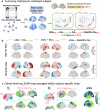Tau follows principal axes of functional and structural brain organization in Alzheimer's disease
- PMID: 38866759
- PMCID: PMC11169286
- DOI: 10.1038/s41467-024-49300-2
Tau follows principal axes of functional and structural brain organization in Alzheimer's disease
Abstract
Alzheimer's disease (AD) is a brain network disorder where pathological proteins accumulate through networks and drive cognitive decline. Yet, the role of network connectivity in facilitating this accumulation remains unclear. Using in-vivo multimodal imaging, we show that the distribution of tau and reactive microglia in humans follows spatial patterns of connectivity variation, the so-called gradients of brain organization. Notably, less distinct connectivity patterns ("gradient contraction") are associated with cognitive decline in regions with greater tau, suggesting an interaction between reduced network differentiation and tau on cognition. Furthermore, by modeling tau in subject-specific gradient space, we demonstrate that tau accumulation in the frontoparietal and temporo-occipital cortices is associated with greater baseline tau within their functionally and structurally connected hubs, respectively. Our work unveils a role for both functional and structural brain organization in pathology accumulation in AD, and supports subject-specific gradient space as a promising tool to map disease progression.
© 2024. The Author(s).
Conflict of interest statement
The authors declare no competing interests.
Figures







References
-
- The Alzheimer’s Association. 2023 Alzheimer’s disease facts and figures. Alzheimers Dement. 19, 1598–1695 (2023). - PubMed
MeSH terms
Substances
Grants and funding
LinkOut - more resources
Full Text Sources
Medical

